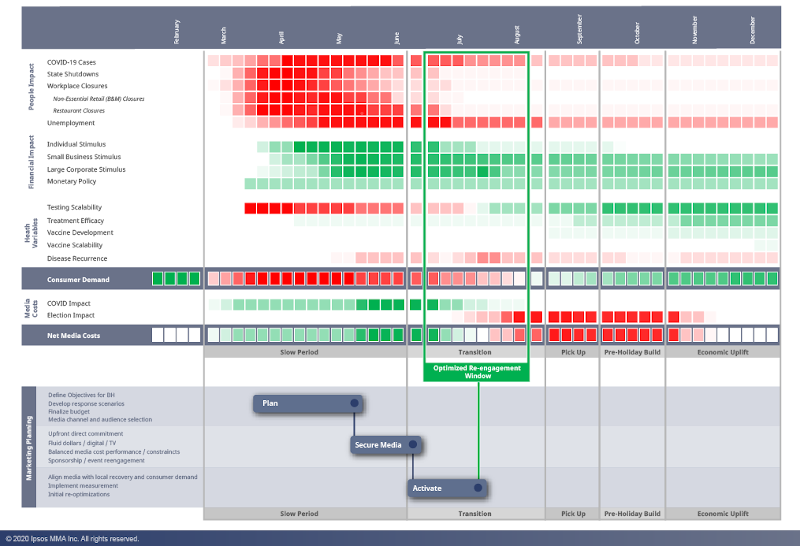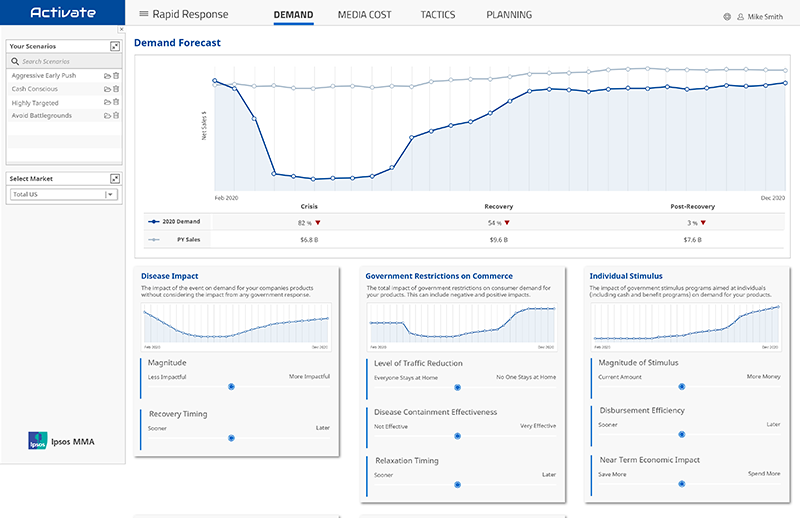Actioning and optimizing your commercial investments against the evolving recovery and consumer demand curve on a real-time basis
Most marketing driven organizations are working through what will effectively be two major cross-waves of planning. The first wave is rolling in now and is all about maximizing revenue and profits for the balance of the year under a significantly altered environment. Rolling in and crossing over it will be the planning cycle wave for 2021. Both will be more complex because companies will need to evaluate and adjust historical performance and metrics for both the short and long-term impacts of the crisis. That will vary by industry, category and brand. Companies that delay run the risk not only of further deepening the impact of the crisis on revenues, but also creating a negative drag on overall brand health and equity going into 2021.
While it’s clear that we still have challenges that lie ahead, this crisis has seen a level of financial stimulus that is unprecedented – with likely more to come. An equally unparalleled effort has come from the pharmaceutical and healthcare industries in the effort to develop testing, treatments, vaccines and PPDs. These extraordinary efforts will in the coming months, coupled with responsible behavior that includes continued social distancing, testing and the use of PPDs, result in people coming back to work and a gradual lift in consumer demand, likely beginning as we move into the summer months and accelerating as we head into the holiday season.
To help in the planning and recovery process, Ipsos MMA has developed a data-informed COVID-19 Demand Heat Map and a dynamic Market Response Simulator that enables marketing and commercial teams to hone in on the intersection between state-level recovery and consumer demand in a real-time manner to create a more accurate forward-looking plan. The heat map and simulator integrate data pertinent to the crisis, market signals, advanced analytics and our experience, spanning 30 plus years of working with leading brands across industries.
COVID-19 DEMAND HEAT MAP

The Heat Map highlights the impact on the demand curve based upon key variable buckets, and our perspective will be updated as needed throughout the crisis:
- People Impact of the virus, shutdowns, workplace closures and unemployment
- Financial Impact of individual, small and large business stimuli and monetary policy
- Health Variables, including testing, treatments, vaccines and disease reoccurrence probabilities
- Media Performance, which considers the demand/costs for the remainder of the year, including the impact of elections
We have projected these variables across 5-periods between now and the end-of-the-year:
- Slow Period – cases gradually level and begin to decline, though we project the decline from the plateau may ebb and flow as states reopen and work through testing and social distancing; stimulus programs in place to stabilize businesses and consumers, some visibility into possible treatments/vaccines
- Transition Period – cases plateauing and beginning to decline with intermittent increases on a state-by-state basis, localized re-openings impact as stimulus takes effect, better clarity into treatments/vaccines, targeted window for media investment as demand starts to increase
- Pick-up Period – virus levels coming down from plateau in most places with continued sporadic (albeit reduced) flare-ups; stimulus in effect and unemployment stabilizing
- Pre-Holiday Build Period – continued declines in virus levels as testing, social distancing, PPDs, ‘herd immunity’ result in improvements; employment improving as holiday season approaches
- Economic Lift Period – improvements across all impact variables, begin to lead to economic recovery, expectations of unprecedented discounting as businesses seek to stimulate consumers and reduce inventories
DOWNLOAD THE COVID 19 DEMAND HEATMAP >
MMA’s COVID-19 Rapid Response Planning module is a web-based simulation and optimization capability that resides within our Activate Unified Marketing Measurement & Optimization platform. It leverages MMA’s Unified MMM/MTA results and updates them dynamically through an advanced algorithm that combines real-time data with expert input to build forward-looking, optimized marketing plans that integrate historical results with current realities to produce the most impactful, efficient and actionable plans for the back-half of 2020 and 2021.
-
- Predict Demand: Modify assumptions around the people, financial and media aspects of the pandemic to build a more accurate prediction of future demand through the phases of the recovery.

- Manage Inventory & Cost: The combination of the pandemic and upcoming presidential election will result in one of the most dynamic and potentially challenging media markets ever. Leverage real-time media inventory and cost data to recalibrate response curves on a weekly basis, by market, to build the most cost-effective media plan.

- Adjust Channels: Dynamically recalibrate media response curves at a market-level by incorporating key people, financial and marketing variables to account for the evolving realities of the recovery.

- Plan & Optimize: As consumer demand evolves during the recovery, have the ability to on a state-by-state basis, continuously re-optimize marketing plans by taking advantage of the dynamic media response curves.

- Predict Demand: Modify assumptions around the people, financial and media aspects of the pandemic to build a more accurate prediction of future demand through the phases of the recovery.
DOWNLOAD COVID-19 RAPID RESPONSE PLANNING INFORMATION SHEET >
Finding the optimal balance across commercial drivers (marketing, promotions, salesforce, operations) will be important for both short-term recovery as well as for sustainable long-term brand performance, especially in this environment. With the demand curve projected to begin building in the near-term and gathering steam as we head into the fourth quarter, the time to plan, secure media, and set in motion activation and execution plans is effectively, now through the next couple of months. In many organizations it’s well underway.
The timing and targeting of media and promotional activities are important as the COVID-19 pandemic has forced many advertisers to “push” significant portions of their ad spend to the back-half. This will result in inventory challenges and cost increases in an already expensive media period with 2020 being an election year. As the year goes on and media inventory becomes scarcer and more expensive, those that are well-informed and act fast will be well positioned, gain share-of-voice and build equity. Arriving late to the party, or not at all, creates scenarios that could be damaging to the brand, including:
- Reducing brand media to the point where the brand has gone “dark” or close to it, giving competitors an opportunity to steal equity during the crisis. Multiple studies and our analysis of past crises have shown that brands that continue to advertise during times of crisis weather the storm in the short and long-term better than those who don’t.
- Creating an over-reliance on discounting and promotions. Following the 2008/2009 Financial Crisis many companies moved to heavy discounting to maintain and bring customers back. These actions resulted in significant erosion of brand equity and long-term sales, compression of brand hierarchies and an increased cost of recovery.
MMA’s advanced algorithm and technology solution for planning employs a unified approach to evaluating marketing, media and promotions on a weekly and local basis factoring in historical performance as well as consumer behaviors during the COVID-19 crisis. The solution will enable companies to optimize media and marketing investments and simulate various short and long-term business performance scenarios during each of the five COVID recovery periods outlined in our COVID-19 Demand Heat Map. This innovative approach adjusts media response curves weekly and by state, based on a comprehensive set of people, financial, health and media variables listed above.



